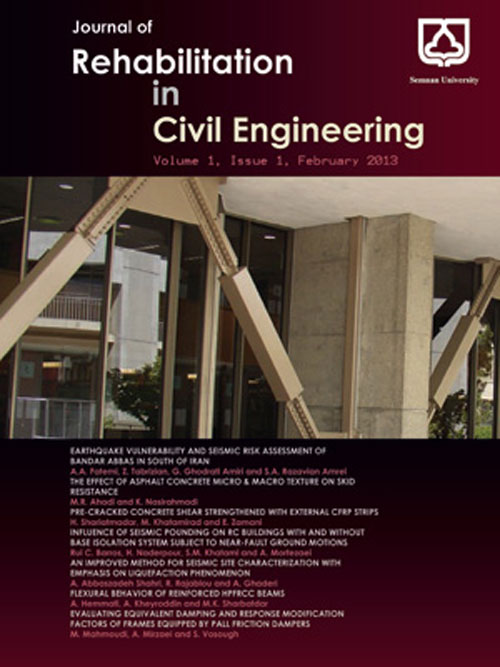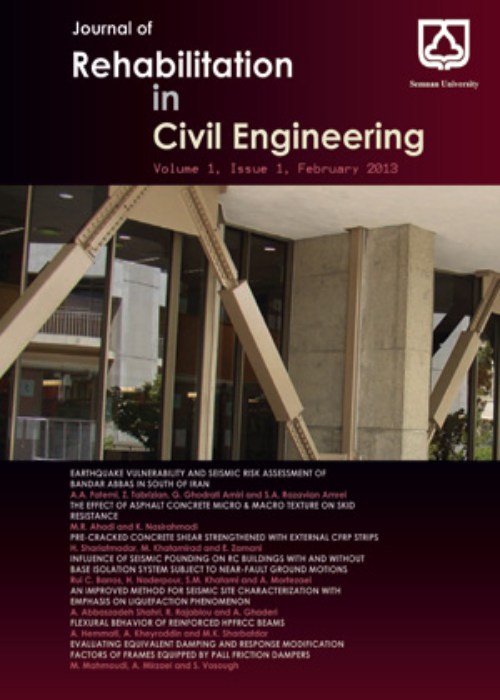فهرست مطالب

Journal of Rehabilitation in Civil Engineering
Volume:3 Issue: 1, Winter - Spring 2015
- تاریخ انتشار: 1394/08/20
- تعداد عناوین: 5
-
-
Pages 1-13Composite couple beams are the concrete elements consisting of longitudinal bars and steel plate, therefore suitable for shear transferring in couple shear walls with arranged gates in its height. In this paper, after modeling couple beams with and without steel plates with F.E methods and calibration the models with experimental results, effects of parameters such as thickness, height, length and yielding strength of the steel plates located in concrete couple composite beam have been investigated on the ductility, energy dissipation and capacity. The results were illustrated that if the plate thickness would be increased by four times, ductility and energy dissipation capacity were decreased 15.6 and 14.7 percent and also loading capacity was enhanced up to 25 percent, respectively. And also the plate height and length didn’t have influence on above mentioned parameters. Furthermore, by 80 and 280 percent enhancement in yielding plate strength, ductility and energy dissipation capacity were decline 10.8 to 23.9 and 8.9 to 21.7 percent and also 19, 33 percent enhancement in loading capacity was happened.Keywords: Composite beams, Steel plate, Energy dissipation, Shear walls, F.E. method, Ductility
-
Pages 14-23A reinforced concrete member in which the total span or shear span is especially small in relation to its depth is called a deep beam. In this study, a new approach based on the Adaptive Neural Fuzzy Inference System (ANFIS) is used to predict the shear strength of reinforced concrete (RC) deep beams. A constitutive relationship was obtained correlating the ultimate load with seven mechanical and geometrical parameters. These parameters contain Web width, Effective depth, Shear span to depth ratio, Concrete compressive strength, Main reinforcement ratio, Horizontal shear reinforcement ratio and Vertical shear reinforcement ratio.The ANFIS model is developed based on 214 experimental database obtained from the literature. The data used in the present study, out of the total data, 80% was used for training the model and 20% for checking to validate the model. The results indicated that ANFIS is an effective method for predicting the shear strength of reinforced concrete (RC) deep beams and has better accuracy and simplicity compared to the empirical methods.Keywords: Shear strength, RC deep beams, Adaptive Neural Fuzzy Inference System (ANFIS)
-
Pages 24-42Results of damage prediction in buildings can be used as a useful tool for managing and decreasing seismic risk of earthquakes. In this study, damage spectrum and C4.5 decision tree algorithm were utilized for damage prediction in steel buildings during earthquakes. In order to prepare the damage spectrum, steel buildings were modeled as a single-degree-of-freedom (SDOF) system and time-history nonlinear analysis was carried out to develop a set of SDOF structures. Then, damage index was used to prepare the damage spectrum. Data parameters required for training and evaluating the C4.5 decision tree algorithm were obtained from the results of damage spectra for steel structures and using Krawinkler damage index Also, two decision trees were trained based on quantitative indices. The first decision tree determined whether damage occurred in buildings or not and the second predicted severity of damage as repairable, beyond repair, or collapse. decision tree classification algorithm was used to predict damage to steel structures.Keywords: Damage prediction, Damage index, Steel buildings, Decision tree algorithm
-
Pages 43-60When structures are subjected to strong ground motion excitations, structural elements may be prone to yielding, and consequently experience significant levels of inelastic behavior. The effects of inelastic behavior on the distribution of peak floor loads are not explicitly accounted for in current seismic code procedures. During recent years, many studies have been conducted to develop new design procedures for different types of buildings through proposing improved design lateral load patterns. One of the most important parameters of structural damage in performance-based seismic design is to limit the extent of structural damages (maximum inter-story ductility ratio) in the system and distribute them uniformly along the height of the structures. In this paper, a practical method is developed for optimum seismic design of zipper-braced frames (ZBF) subjected to seismic excitations. More efficient seismic design is obtained by redistributing material from strong to weak parts of a structure until a state of uniform ductility ratio (damage) prevails. By applying the proposed design algorithm on 5, 10 and 15‐storey zipper-braced frames subjected to 10 synthetic seismic excitations, the efficiency of the proposed method is investigated for specific synthetic seismic excitations. The results indicate that, for a constant structural weight, the structures designed according to the proposed optimization algorithm experience up to 50% less global ductility ratio (damage) compared with code-based design structures.Keywords: Zipper, braced Frame structures, maximum damage, uniform ductility distribution, inelastic behavior, strong ground motion excitation
-
Pages 61-73Spending costs in construction of road pavements has turned this subject into one of the significant points in transportation infrastructure of countries. Concrete slabs consider as a paving method with ability of reducing the rehabilitation needs. Therefore, to manage costs and optimize the thickness of concrete pavements, recognizing the amount of determinative factors’ influence will be required. A study with the aim of determining the influence of traffic parameters, type of subgrade soil and the base layer thickness on the concrete pavement slab thickness can provide the choice of best concrete pavement design. For this purpose, the PCASE software has been used in this paper to construct sufficient number of numerical examples, 288 specimens, with taking into account the number of equivalent single axle, the subgrade modulus of concrete pavement construction place and the base layer thickness. These samples are considered as the basis of training and testing an artificial neural network and the level of pavement design parameters importance is relatively determined on the results of optimal neural network. The method used in this paper for calculating the relative importance of each parameter involved in the concrete pavement thickness indicates that the parameters of base layer thickness and the number of equivalent single axle have the lowest and highest level of influence, with the values of about 21 and 42 percent, respectively. The obtained results are also compatible with concepts and structural features of concrete pavements.Keywords: concrete pavement, pavement design, PCASE, neural network, relative importance


